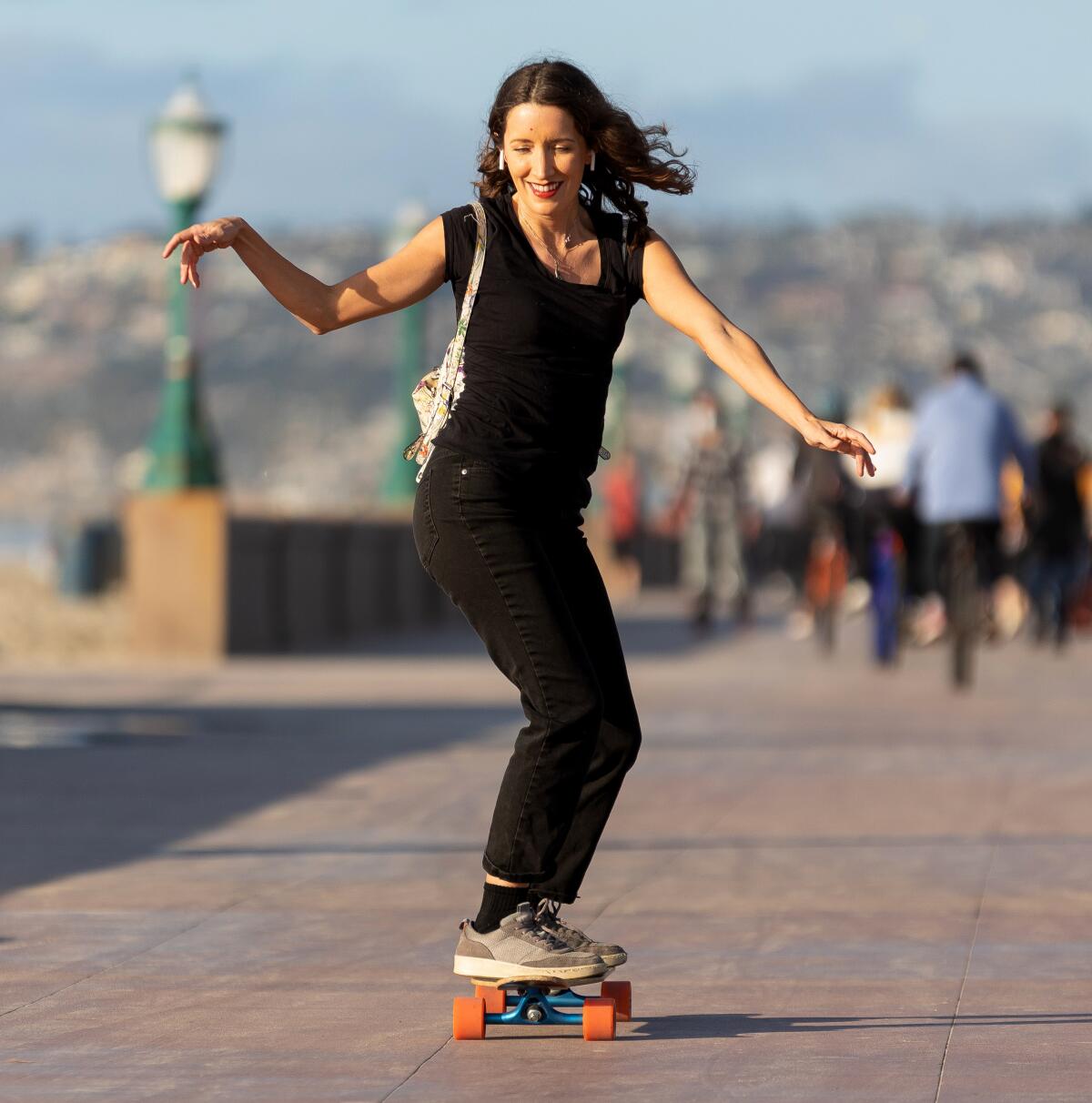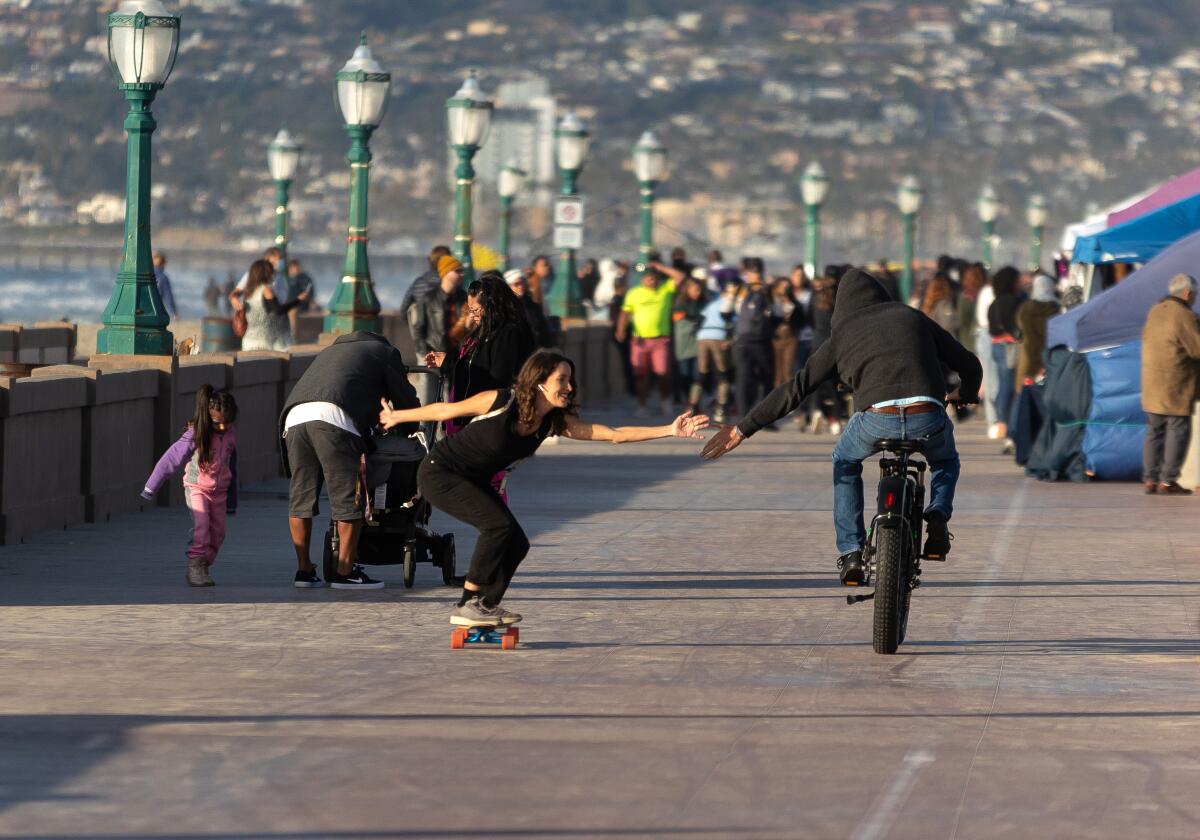In a year of plague and insurrection, a longboard saved me

- Share via
When an unexpected gift hit my doorstep in the spring of 2020, I knew nothing about longboard dancing.
The California-made Loaded Tan Tien was a long bamboo skateboard, with kaleidoscopic tiger stripes on its base and bright orange wheels. It looked silly. I had no idea it would soon soothe my anxiety from the pandemic and the right’s assault on democracy, much less become a primary source of joy.
Whether you’re a goofy dad and proud cholo like Nathan Apodaca, who went viral longboard dancing to Fleetwood Mac en route to work in Idaho, or a graceful model like South Korea’s Kyo Hyojoo pirouetting through city streets, longboard dancing offers a refuge from an unraveling world. As Apodaca, or “Doggface,” told me: “It’s very freakin’ therapeutical.”
Opinion Columnist
Jean Guerrero
Jean Guerrero is the author, most recently, of “Hatemonger: Stephen Miller, Donald Trump and the White Nationalist Agenda.”
A friend sent me the longboard as COVID-19 beach closures in my hometown of San Diego kept me from bodyboarding, which I’d picked up after Trump’s election to stay sane. Skimming the ocean’s surface had restored my center of gravity at a time when I felt unmoored by my country’s direction, and I missed it.
My friend told me the longboard might help until the beaches reopened. He texted me a promo video for the Tan Tien in which a rider carves up the asphalt while doing breathtaking dance-like footwork: cross steps, 180s, Peter Pans (crisscrossing feet in the deck’s center for sinuous carves) and more.
I drove to an empty parking lot on the bay and began to practice. I had little interest in longboarding anywhere besides the edge of the world: along the coastline, in close proximity to the water.
There is something about growing up on the border that cultivates an allegiance to the in-between, the neither here nor there, the liminal spaces. Longboarding is liminality unleashed. It’s the ocean at its crescendo, just before crashing ashore. Carving along, I became its smooth flow and accrued force.
I only later learned that my father skated when he first came from Mexico as a teen. Sometimes, I like to imagine that the magic of his board could safely bypass all the traumas in his life and people he hurt. He’d hurtle past my mother, a risk-averse physician rooted in reality and rules; past the addictions of his 40s; past the paranoia of his 50s and 60s — all receding into the infinity of a skater’s jubilance. But then I wouldn’t exist.
Nathan Apodaca, known on TikTok as @420doggface208, went viral for a video of him skateboarding to Fleetwood Mac’s ‘Dreams.’ Meet the man behind the viral clip.
I live in the oppositional pull of my parents, of otherness and belonging, of trust and distrust in authority. In a year of plague and insurrection, longboarding freed me of polarization.
But it wasn’t until the boardwalks reopened that I discovered the breadth of longboarding’s beauty. Cruising from Mission Beach to Pacific Beach absorbed in house music, I felt a joy so full I couldn’t help but dance, even though I hadn’t mastered any longboard-dancing steps. I swayed, leaning into serpentine carves. I bounced with the bass on my board. I stretched my arms out and threw my head back to the clouds.

Yes, I looked ridiculous. And passersby laughed — not with scorn, but with delight and amusement. A middle-aged white woman bopped her head along with me. A fellow Latina skater fist-bumped me. A silver-haired man pointed at my NASA hoodie and cried: “I get it! You are out of this world.”
At first, longboarding was a solitary spiritual activity for me. Dancing unlocked its social magic. It sparked human connection, however fleeting, and with it, hope.
I became obsessed. I grooved from Venice Beach to Santa Monica. Hope and connection were there. I glided from Redondo Beach to Hermosa Beach. Hope and connection were there. I bought a small pastel-colored skateboard with light-up wheels for my six-year-old niece and got her hooked. Hope and connection were there.
In Spanish, the word for hope is “esperanza,” which mirrors the word for waiting: “esperar.” When I’m longboard dancing and interacting with strangers, the feeling of waiting — or bracing for the world to collapse — explodes into hope.
No matter what President Biden does, Republicans will attack his policies as “open borders.”
A smile, merely acknowledging strangers in our lives, improves our moods. Studies show the mental health benefits. Despite spending my early 20s in Mexico, where people often greet each other warmly, I’d learned to keep my head down here again; COVID-19 made the urge to scurry away from strangers worse. But longboard dancing gave me a safe way to interact — and made me eager to do it.
Eventually, I got the courage to try longboard-specific dance steps. The 180s and switch-step 180s came easily. Cross steps were harder and I tripped. Learning Peter Pans, I bloodied my chin. But even the scrapes were a throwback to childhood, to the regeneration and healing and trying again.
Apodaca, the goofy dad who went so viral grooving that he’s planning his own longboard model, told me he loves the shared bliss it creates too: “I do it for the smiles I get from people coming up to me, just ecstatic to see me vibing and doing me.”
Amen to that. Rejoicing in the lives of strangers as we revel in the ride may save us yet.
- Share via
Watch L.A. Times Today at 7 p.m. on Spectrum News 1 on Channel 1 or live stream on the Spectrum News App. Palos Verdes Peninsula and Orange County viewers can watch on Cox Systems on channel 99.
More to Read
A cure for the common opinion
Get thought-provoking perspectives with our weekly newsletter.
You may occasionally receive promotional content from the Los Angeles Times.













